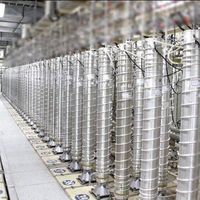Inside the grim reality of Tehran’s rental market
Iranians report housing prices rising by 50 percent year on year with rental costs now roughly twice the average salary, causing huge economic and social chaos on a country already in the depths of recession.
Iran's ongoing housing crisis has seen a 70-square meter apartment in one of Tehran's cheapest neighborhoods, Berianak, now cost at least $460 a month, way beyond the average salary of around $240 a month.
To delve deeper into the issue, we investigated the cheapest districts in Tehran to examine the costs of a modest flat. Districts 15, 16, 17, 18, 19, and 20 in the southern capital are known as the cheapest areas for renting and buying houses.
Divar, a classified ads and e-commerce mobile app, is widely used in Iran to check real estate prices. Founded in 2012, Divar serves as an online platform for real estate, vehicles, goods, community services, industrial equipment, and jobs. Our research converted deposit amounts and monthly rents to US dollars for better reader understanding, using the day's exchange rate of 580,000 rials per dollar.
In Iran, the deposit is treated as part of the total rent. Paying a deposit of 1,000,000,000 rials ($1,700) upfront can reduce the monthly rent by 30,000,000 rials (over $50). Alternatively, depositing the same amount in a bank can yield a monthly return of 20,000,000 rials ($35).
A 50-square-meter apartment in Shahrak-e Valiasr in District 18 is offered for 125,000,000 rials per month, or about $215. This leaves an average income earner with only $25 for other expenses for a family to live on for a month.
A larger but older apartment is offered for 225,000,000 rials ($387) per month. This flat is nearly 20 years old but has been newly painted and refurbished.
In the southernmost neighborhoods, such as district 20, mostly the Rey region, a 40-square-meter flat is advertised for $205 per month. Another flat without a lift and parking space, located on the third floor and 15 years old, is offered for $230. The owner is willing to rent it to a single person, a rare option, especially for single women who often struggle to find suitable housing.
In districts 15, 16, 17, and 19, the monthly rent for a 50-square-meter apartment ranges from $200 to $400, depending on factors such as age, parking space, number of floors, and proximity to amenities like parks, schools, and the metro.
Empty promises from officials to reduce rent rates
On Wednesday, the Minister of Roads and Urban Development, Mehrdad Bazrpash, stated that “the cap on housing rent increases in the provinces was set at an average of 25%” for the current year (ending in March).
However, in reality, rents have increased by nearly 50% compared to the previous year according to the Vice President of the Real Estate Union, Davoud Beiginejad, citing data from the Central Bank and completed transactions.
This starkly contradicts all the promises the government has made regarding the reduction of housing rent.
Criticizing the policy announced by the minister, Namad-e Eqtesad, an economic website, wrote that mandated actions in the market are detrimental to both the market and tenants, such policies possibly leading to a decrease in the supply of rental housing.
"Currently, paying rent has become unaffordable for a large number of tenant households, and the fact that some groups are still managing to pay rent under the current conditions is nothing short of a miracle," the site noted.
Mahan, who married two years ago, works for a private company and told Iran International that his salary is about 170,000,000 rials ($295) monthly. He lives in a flat in Tehransar, southwest of Tehran.
His wife is a housewife, and he is the sole breadwinner. They have no children yet. He says he rented a flat for $150 right after marriage, but the landlord asked for $200 the following year and $300 this year to renew the contract.
"I am so desperate. I don’t know what to do. This means I have to pay more than my income for rent, and nothing will be left to live on. We are thinking of getting divorced and living with our parents," he added.
We also spoke with Mahdi, a worker at a furniture workshop in Mortezagerd near Tehran. He is a father of two and works 14 hours a day to make ends meet, but still struggles.
His wife runs an online clothing shop. Together, they earned almost $400 monthly last year, but with nearly 50% inflation and the rise of the US dollar against the rial, their income has dramatically dropped. Mahdi said he paid $200 for rent per month last year but now has to pay $300, which consumes all their income after the rial's depreciation.
Reza Gheibi, an economic journalist, told Iran International that the rise in the cost of land, labor, and construction materials amid heavy global sanctions on the country has all contributed to the increase in housing prices and rents.
He predicted this trend will continue as it began in February with the rise of the US dollar against the rial, and after a few months, its effect on the rent market became evident. "The coming months will see worse incidents, especially for tenants," he predicted.
Almost two thirds of Iran's population now live below the poverty line, with record unemployment and ongoing international sanctions which have seen even Iran's educated middle class thrust into poverty.







